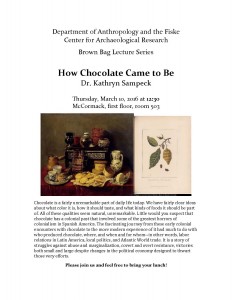How Chocolate Came to Be
Dr. Kathryn Sampeck
Thursday, March 10, 2016 at 12:30
McCormack, first floor, room 503
Chocolate is a fairly unremarkable part of daily life today. We have fairly clear ideas about what color it is, how it should taste, and what kinds of foods it should be part of. All of these qualities seem natural, unremarkable. Little would you suspect that chocolate has a colonial past that involved some of the greatest horrors of colonialism in Spanish America. The fascinating journey from these early colonial encounters with chocolate to the more modern experience of it had much to do with who produced chocolate, where, and when and for whom–in other words, labor relations in Latin America, local politics, and Atlantic World trade. It is a story of struggles against abuse and marginalization, covert and overt resistance, victories both small and large despite changes in the political economy designed to thwart those very efforts.
Dr. Kathryn Sampeck who is a visiting scholar at Harvard this semester will be coming to talk about her archaeological and ethnographic research on chocolate and the people who produced and consumed it.

